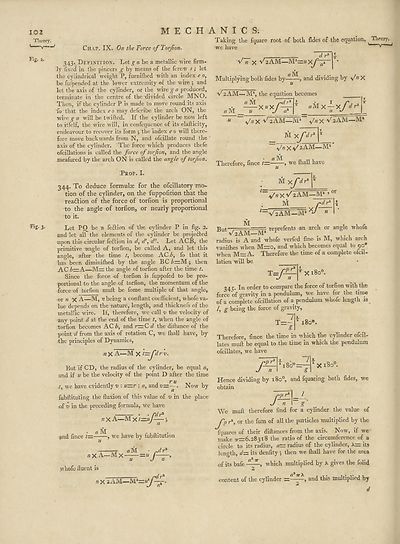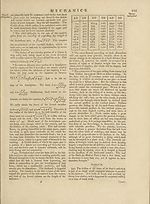Encyclopaedia Britannica, or, a Dictionary of arts, sciences, and miscellaneous literature : enlarged and improved. Illustrated with nearly six hundred engravings > Volume 13, MAT-MIC
(110) Page 102
Download files
Complete book:
Individual page:
Thumbnail gallery: Grid view | List view

102
Theory.
MEGHAN I C S;
Fig- 3-
Chap. IX. On the Force of Torjion.
343. Definition. Let ^ rr be a metallic "wire firm¬
ly fixed in the pincers g by means of the fcreW s ; let
the cylindrical weight P, furnifhed with an index e 0,
be fufpended at the lower extremity of the wire •, and
let the axis of the cylinder, or the wire g a produced,
terminate in the centre of the divided circle MNO.
Then, if the cylinder P is made to move round its axis
do that the index eo may deferibe the arch ON, the
wire g a will be twilled. If the cylinder be now left
to itfelf, the wire will, in confeguence of its elafticity,
endeavour to recover its form *, the index e 0 will there¬
fore move backwards from N, and ofcillate round the
axis of the cylinder. The force which produces thefe
ofeillations is called the force of torfon, and the angle
meafured by the arch ON is called the angle of torfon.
Prop. L
344. To deduce formulse for the ofcillatory mo¬
tion of the cylinder, on the fuppofition that the
rea&ion of the force of torfion is proportional
to the angle of torfion, or nearly proportional
to it.
72 x A—M x t~JIrv.
• • rd r*
/; X A—M x t—uj j
y a
and finee tzz? —, wTe have by fubftitution
iM
dr*
n X A— M X =« C—
u J a
whofe fluent is
n X 2AM—
Taking the fejuare root of both fides of the equation. ^ Theory,
we have v'
. d j-1
v n X v 2AM—
Multiplying both fides by , and dividing by \ln X
But if CD, the radius of the cylinder, be equal «,
and if tt be the velocity of the point D after the time
r u
t, we have evidently v : u~r : o, and v——. Now by
fubftituting the fluxion of this value of v in the place
of v in the preceding formula, wve have
V2 AM—M% the equation becomes
« M fdr
— x«x/ —
!2 J a
aU
oM x
1 /* 7
' fn X V 2AM_M~ x/n X V 2AM—M*
M xfd r'
Vn X -1/2AM—M*
Therefore, fince /—we fliall have
u
M xf‘
'dr*
v'kx/sAM—M» >or
M pd r
V2AM—-M* n
Let PC) be a feel ion of the cylinder P in fig. 2.
and let all the elements of the cylinder be projefted
upon this circular feftion in 2/, d’, d". Let ACB, the
primitive angle of torfion, be called A, and let this
angle, after the time /, become AC b, fo that it
has been diminiftied by the angle BCZ>—Mq then
AC b—A—Mm the angle of torfion after the time t.
Since the force of torfion is fuppofed to be pro¬
portional to the angle of torfion, the momentum of the
force of torfion mull be fome multiple of that angle,
or 22 X A—M, 22 being a conftant coefficient, whofe va¬
lue depends on the nature, length, and thicknefs of the
metallic wire. If, therefore, we call v the velocity of
any point d at the end of the time t, when the angle of
torfion becomes AC b, and r~C d the diilance of the
point d from the axis of rotation C, we fliall have, by
£he principles of Dynamics,
M
■Rut—7==-^==== renrefents an arch or angle whof®
^UV2AM—Ml 1 * t
radius is A and whofe verfed fine is M, which arch
vanilhes when IVI~o, and which becomes equal to 90
when M=rA. Therefore the time of a complete ofcil-
lation will be
•p r*
t=f-n
X 1800.
345. In order to compare the force of torfion with the
force of gravity in a pendulum, We have for the time
of a complete ofcillation of a pendulum whofe length is
/, g being the force of gravity,
T
T=
§
180®.
•p A
rP*
J 22
Therefore, fince the time in which the cylinder ofcil-
lates muft be equal to the time in which the pendulum
ofcillates, we have
’ a ^ 7 i.
- x i8o°=— x X 1800.
S
Hence dividing by 1800, and fquaring both fides, we
obtain
rp A 1 /
J n \ g'
We mull therefore find for a cylinder the value of
jTp r1, or the fum of all the particles multiplied by the
fquares of their diftances from the axis. Now, if we
make ^=6.28318 the ratio of the circumference of a
circle to its radius, a— radius of the cylinder, *= its
length, d— its denfity •, then we fliall have for the area
of its bafe which multiplied by A gives the folid
2
content of the cylinder , and this multiplied by
Theory.
MEGHAN I C S;
Fig- 3-
Chap. IX. On the Force of Torjion.
343. Definition. Let ^ rr be a metallic "wire firm¬
ly fixed in the pincers g by means of the fcreW s ; let
the cylindrical weight P, furnifhed with an index e 0,
be fufpended at the lower extremity of the wire •, and
let the axis of the cylinder, or the wire g a produced,
terminate in the centre of the divided circle MNO.
Then, if the cylinder P is made to move round its axis
do that the index eo may deferibe the arch ON, the
wire g a will be twilled. If the cylinder be now left
to itfelf, the wire will, in confeguence of its elafticity,
endeavour to recover its form *, the index e 0 will there¬
fore move backwards from N, and ofcillate round the
axis of the cylinder. The force which produces thefe
ofeillations is called the force of torfon, and the angle
meafured by the arch ON is called the angle of torfon.
Prop. L
344. To deduce formulse for the ofcillatory mo¬
tion of the cylinder, on the fuppofition that the
rea&ion of the force of torfion is proportional
to the angle of torfion, or nearly proportional
to it.
72 x A—M x t~JIrv.
• • rd r*
/; X A—M x t—uj j
y a
and finee tzz? —, wTe have by fubftitution
iM
dr*
n X A— M X =« C—
u J a
whofe fluent is
n X 2AM—
Taking the fejuare root of both fides of the equation. ^ Theory,
we have v'
. d j-1
v n X v 2AM—
Multiplying both fides by , and dividing by \ln X
But if CD, the radius of the cylinder, be equal «,
and if tt be the velocity of the point D after the time
r u
t, we have evidently v : u~r : o, and v——. Now by
fubftituting the fluxion of this value of v in the place
of v in the preceding formula, wve have
V2 AM—M% the equation becomes
« M fdr
— x«x/ —
!2 J a
aU
oM x
1 /* 7
' fn X V 2AM_M~ x/n X V 2AM—M*
M xfd r'
Vn X -1/2AM—M*
Therefore, fince /—we fliall have
u
M xf‘
'dr*
v'kx/sAM—M» >or
M pd r
V2AM—-M* n
Let PC) be a feel ion of the cylinder P in fig. 2.
and let all the elements of the cylinder be projefted
upon this circular feftion in 2/, d’, d". Let ACB, the
primitive angle of torfion, be called A, and let this
angle, after the time /, become AC b, fo that it
has been diminiftied by the angle BCZ>—Mq then
AC b—A—Mm the angle of torfion after the time t.
Since the force of torfion is fuppofed to be pro¬
portional to the angle of torfion, the momentum of the
force of torfion mull be fome multiple of that angle,
or 22 X A—M, 22 being a conftant coefficient, whofe va¬
lue depends on the nature, length, and thicknefs of the
metallic wire. If, therefore, we call v the velocity of
any point d at the end of the time t, when the angle of
torfion becomes AC b, and r~C d the diilance of the
point d from the axis of rotation C, we fliall have, by
£he principles of Dynamics,
M
■Rut—7==-^==== renrefents an arch or angle whof®
^UV2AM—Ml 1 * t
radius is A and whofe verfed fine is M, which arch
vanilhes when IVI~o, and which becomes equal to 90
when M=rA. Therefore the time of a complete ofcil-
lation will be
•p r*
t=f-n
X 1800.
345. In order to compare the force of torfion with the
force of gravity in a pendulum, We have for the time
of a complete ofcillation of a pendulum whofe length is
/, g being the force of gravity,
T
T=
§
180®.
•p A
rP*
J 22
Therefore, fince the time in which the cylinder ofcil-
lates muft be equal to the time in which the pendulum
ofcillates, we have
’ a ^ 7 i.
- x i8o°=— x X 1800.
S
Hence dividing by 1800, and fquaring both fides, we
obtain
rp A 1 /
J n \ g'
We mull therefore find for a cylinder the value of
jTp r1, or the fum of all the particles multiplied by the
fquares of their diftances from the axis. Now, if we
make ^=6.28318 the ratio of the circumference of a
circle to its radius, a— radius of the cylinder, *= its
length, d— its denfity •, then we fliall have for the area
of its bafe which multiplied by A gives the folid
2
content of the cylinder , and this multiplied by
Set display mode to:
![]() Universal Viewer |
Universal Viewer | ![]() Mirador |
Large image | Transcription
Mirador |
Large image | Transcription
Images and transcriptions on this page, including medium image downloads, may be used under the Creative Commons Attribution 4.0 International Licence unless otherwise stated. ![]()
| Permanent URL | https://digital.nls.uk/192662592 |
|---|
| Attribution and copyright: |
|
|---|
| Description | Ten editions of 'Encyclopaedia Britannica', issued from 1768-1903, in 231 volumes. Originally issued in 100 weekly parts (3 volumes) between 1768 and 1771 by publishers: Colin Macfarquhar and Andrew Bell (Edinburgh); editor: William Smellie: engraver: Andrew Bell. Expanded editions in the 19th century featured more volumes and contributions from leading experts in their fields. Managed and published in Edinburgh up to the 9th edition (25 volumes, from 1875-1889); the 10th edition (1902-1903) re-issued the 9th edition, with 11 supplementary volumes. |
|---|---|
| Additional NLS resources: |
|

